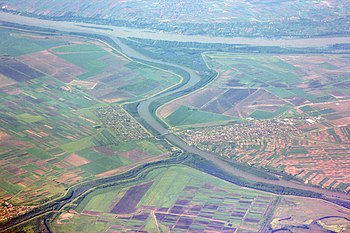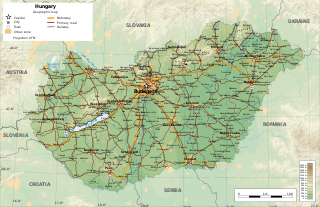
Hungary is a landlocked country in the southeastern region of Central Europe, bordering the Balkans. Situated in the Pannonian Basin, it has a land area of 93,030 square km, measuring about 250 km from north to south and 524 km from east to west. It has 2,106 km of boundaries, shared with Slovakia to the north, Ukraine to the northeast, Romania to the east and southeast, Serbia to the south, Croatia to the southwest, Slovenia to the west and southwest, and Austria to the west.

Banat is a geographical and historical region located in the Pannonian Basin that straddles Central and Eastern Europe. It is currently divided among three countries: the eastern part lies in western Romania ; the western part of Banat is in northeastern Serbia ; and a small northern part lies within southeastern Hungary.

The Mureș or Maros is a 789-kilometre-long (490 mi) river in Eastern Europe. Its drainage basin covers an area of 30,332 km2 (11,711 sq mi). It originates in the Hășmașu Mare Range in the Eastern Carpathian Mountains, Romania, rising close to the headwaters of the river Olt, and joins the Tisza at Szeged in southeastern Hungary. In Romania, its length is 761 km (473 mi) and its basin size is 27,890 km2 (10,770 sq mi).

Csongrád-Csanád is an administrative county in southern Hungary, straddling the river Tisza, on the border with Serbia and Romania. It shares borders with the Hungarian counties Bács-Kiskun County, Jász-Nagykun-Szolnok County and Békés. The administrative centre of Csongrád-Csanád county is Szeged. The county is also part of the Danube–Criș–Mureș–Tisa Euroregion.

The Körös or Criș is a river in eastern Hungary and western Romania. Its length is 128.6 km (79.9 mi) from the confluence of its two source rivers Fehér-Körös and Fekete-Körös to its outflow into the Tisza. Its drainage basin area is 27,537 km2 (10,632 sq mi). It has three source rivers, all with their origin in the Apuseni Mountains in Transylvania, Romania: Crișul Alb (Fehér-Körös), Crișul Negru (Fekete-Körös) and Crișul Repede (Sebes-Körös). The confluence of the rivers Fehér-Körös and Fekete-Körös is near the town Gyula. The Körös downstream from Gyula is also called the Kettős-Körös. 37.3 km further downstream, near Gyomaendrőd, the Sebes-Körös joins the Körös/Criș. The section downstream from Gyomaendrőd is also called the Hármas-Körös. The Körös flows into the Tisza River near Csongrád.

The Târnava is a river in Romania. It is formed by the confluence of the Târnava Mare and Târnava Mică in the town of Blaj. The Târnava flows into the Mureș after 23 km near the town of Teiuș. The two source rivers of the Târnava are the Târnava Mare and Târnava Mică, and its tributaries include the Tur, Izvorul Iezerului, Secaș, and the Dunărița. Its drainage basin covers an area of 6,253 km2 (2,414 sq mi).

The Pannonian Basin, or Carpathian Basin, is a large sedimentary basin situated in southeast Central Europe. After the WW1 and Treaty of Trianon, the geomorphological term Pannonian Plain became more widely used for roughly the same region though with a somewhat different sense, with only the lowlands, the plain that remained when the Pliocene Epoch Pannonian Sea dried out.

The Crișul Alb (Romanian), is a river in western Romania, in the historical region of Transylvania, and in south-eastern Hungary.
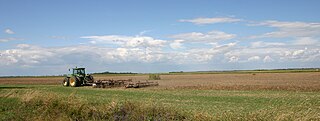
The Great Hungarian Plain is a plain occupying the majority of the modern territory of Hungary. It is the largest part of the wider Pannonian Plain. Its territory significantly shrank due to its eastern and southern boundaries being adjusted by the new political borders created after World War I when the Treaty of Trianon was signed in 1920.
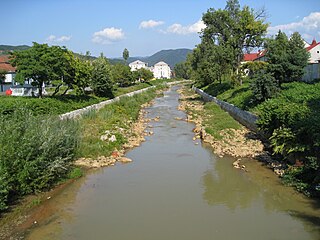
The Săsar is a right tributary of the river Lăpuș in Maramureș County, Romania. It discharges into the Lăpuș in Bozânta Mare, southwest of Baia Mare. It is a medium-size river which flows through the cities of Baia Sprie and Baia Mare. Its length is 31 km (19 mi) and its basin size is 306 km2 (118 sq mi).

The Someș or Szamos is a left tributary of the Tisza in Hungary and Romania. It has a length of 415 km (258 mi), of which 50 km are in Hungary. The Someș is the fifth largest river by length and volume in Romania. The hydrographic basin forms by the confluence at Mica, a commune about 4 km upstream of Dej, of Someșul Mare and Someșul Mic rivers. Someșul Mic originates in the Apuseni Mountains, and Someșul Mare springs from the Rodna Mountains.
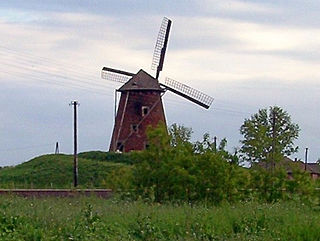
Jász–Nagykun–Szolnok is an administrative county in Hungary. It lies in central Hungary and shares borders with the Hungarian counties Pest, Heves, Borsod–Abaúj–Zemplén, Hajdú–Bihar, Békés, Csongrád, and Bács–Kiskun. The rivers Tisza and Körös flow through the county. The capital of Jász–Nagykun–Szolnok county is Szolnok. Its area is 5582 km2. The county is named after the Ossetians (Jasz) and Cumans (Kun) who settled there, along with Szolnok. The county was part of the Danube–Criș–Mureș–Tisa Euroregion between 1997 and 2004.

Pomorišje is a historical geographical region on the banks of the river Mureș that in the past has had a sizable ethnic Serb population. The region is mostly divided between Romania and Hungary, with small part of it in northern Serbia. Today, a Serb minority is present in parts of the region that are part of Romania and Hungary.

The Bega or Begej, is a 244 km long river in Romania and Serbia. It rises in the Poiana Ruscă Mountains in Romania, part of the Carpathian Mountains, and it flows into the Tisa river near Titel, Vojvodina, Serbia. Its drainage basin covers an area of 4,458 km2 (1,721 sq mi), of which 2,362 km2 (912 sq mi) in Romania.

The hydrology of Hungary, is mostly determined by Hungary's lying in the middle of the Carpathian Basin, half surrounded by the Carpathian Mountains. All parts of the country have some outflow. All surface water gravitates towards its southern center, and from there, is united in the Danube, which flows into the Black Sea. The whole of Hungary lies within the Danube drainage basin.

The 2000 Baia Mare Cyanide spill was a leak of cyanide near Baia Mare, Romania, into the Someș River by the gold mining company Aurul, a joint-venture of the Australian company Esmeralda Exploration and the Romanian government.
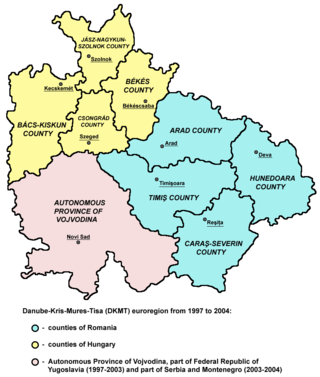
The Danube–Criș–Mureș–Tisa Euroregion is a euroregion located in Hungary, Romania and Serbia. It is named after four rivers: Danube, Criș, Mureș and Tisa.
Danube–Tisza Interfluve is the landscape in Hungarian territory in the Pannonian Basin between the Danube and Tisza rivers, east of Transdanubia. It covers a large part of the Great Hungarian Plain.



